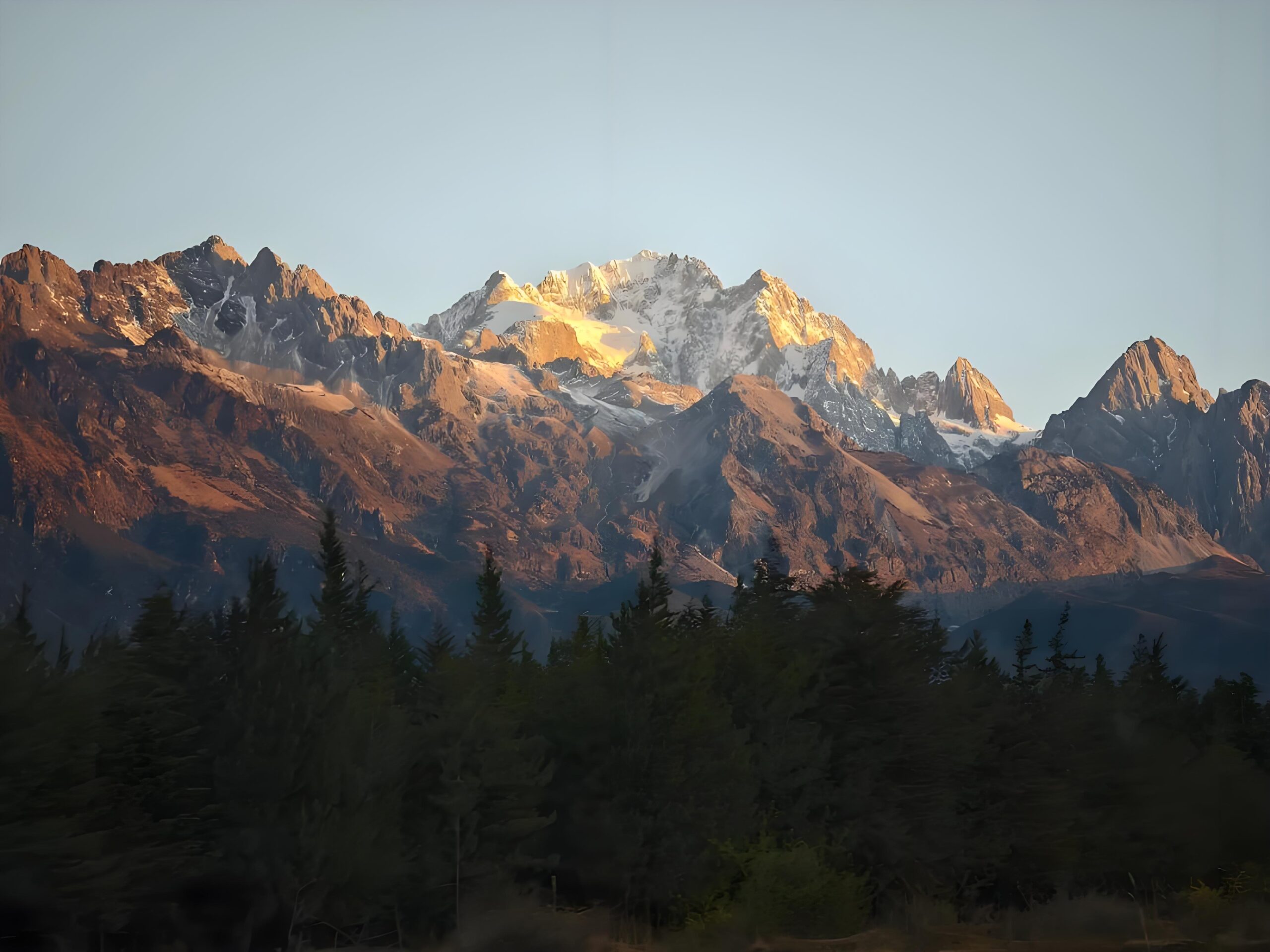Jade Dragon Snow Mountain: The Ultimate Travel Guide to Yunnan’s Sacred Peak
Towering majestically above Lijiang‘s ancient cobblestone streets, Jade Dragon Snow Mountain emerges as one of China’s most breathtaking natural wonders. This sacred peak has captivated travelers for centuries with its pristine glaciers, mystical legends, and dramatic elevation changes that create multiple climate zones within a single day’s journey.
Having guided countless travelers through this remarkable landscape over the past two decades, we can confidently say that Jade Dragon Snow Mountain offers an experience unlike any other mountain destination in China. The contrast between the subtropical valleys at its base and the arctic conditions at its summit creates a unique ecosystem that houses rare species found nowhere else on Earth.
Quick Facts
Location: Northwest of Lijiang Old Town, Yunnan Province, China
Highest Peak: Shanzidou (Fan Steep) at 5,596 meters (18,360 feet)
Alternative Names: Yulong Xueshan, Mount Yulong, Yulong Snow Mountain
Mountain Range: 13 peaks forming a continuous snow-capped ridge
Sacred Status: Holy mountain of the Naxi people
Climate Zones: 7 distinct zones from subtropical to arctic
Protected Area: National Scenic Area and UNESCO World Heritage buffer zone
Best Viewing Season: October to April for clear mountain views
Maximum Tourist Elevation: 4,680 meters via Glacier Park cable car
The mountain’s Chinese name “玉龙雪山 Yùlóng Xuěshān” literally translates to “Jade Dragon Snow Mountain,” reflecting both its serpentine silhouette against the sky and the precious jade-like quality of its perpetual snow cover.
Table of Contents
History and Cultural Significance
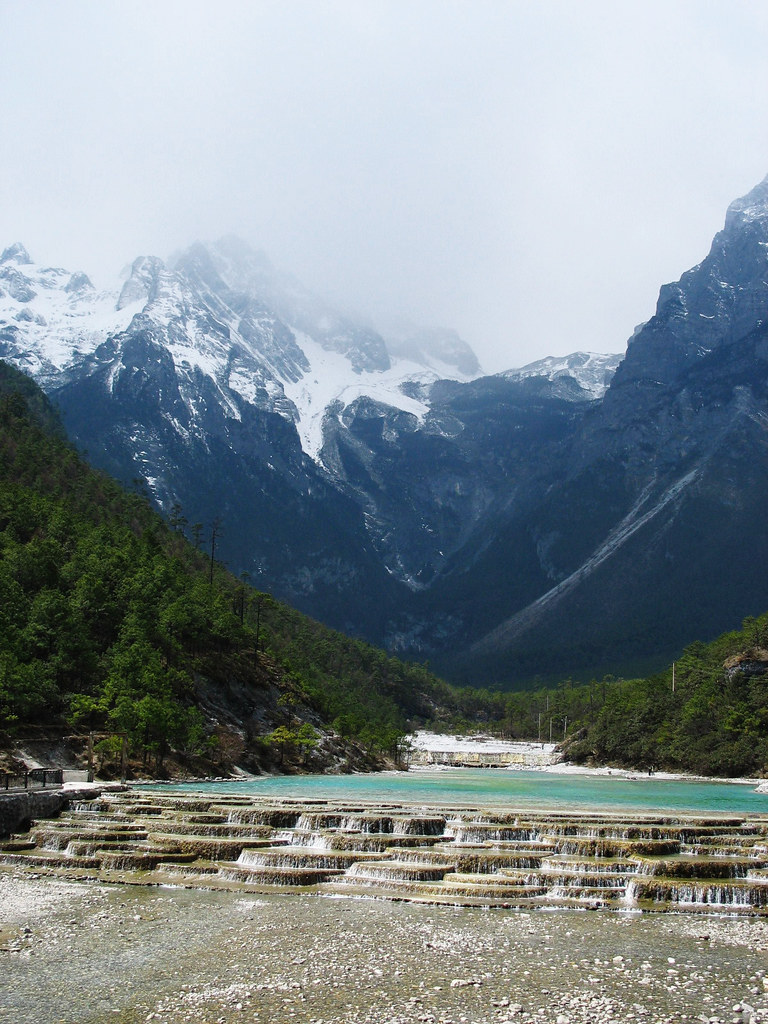
Ancient Naxi Traditions and Sacred Beliefs
For over 1,000 years, the Naxi people have revered Jade Dragon Snow Mountain as the dwelling place of Sanduo, their most important protective deity and war god. This spiritual connection runs so deep that traditional Naxi festivals still honor the mountain’s sacred presence today.
The mountain holds particular significance in Naxi creation mythology. Revered by the Naxi people, it represents their protector, the war god Sanduo. According to ancient beliefs, Sanduo manifests as a young warrior dressed in white armor, riding a white horse, and carrying a white spear – imagery that perfectly mirrors the mountain’s snow-covered peaks.
The Legend of the Third Kingdom
One of the most poignant cultural stories associated with Jade Dragon Snow Mountain involves the mythical “Third Kingdom of Jade Dragon” or “Yulong Third Country.” The Spruce Meadow, at an elevation of 3,240 meters, is considered a holy land and the gateway to the mythical “Yulong Third Country,” a utopia of eternal happiness.
This legend tells of young lovers who, forbidden to marry in the earthly realm, would journey to the mountain’s heights to enter this eternal paradise together. The story has made the mountain a symbol of pure, undying love in Naxi culture, and couples still visit to pledge their devotion beneath its towering peaks.
Historical Expeditions and Modern Recognition
The mountain remained largely unexplored by outsiders until the 20th century, when it began attracting international attention for its biological diversity and unique glacial formations. Today, it stands as part of the broader Three Parallel Rivers of Yunnan Protected Areas, a UNESCO World Heritage site that recognizes the region’s exceptional natural value.
Why Jade Dragon Snow Mountain is Worth Visiting

Unparalleled Biodiversity in Vertical Ecosystems
What makes Jade Dragon Snow Mountain truly extraordinary is its incredible elevation range, creating what scientists call “vertical zonation.” From the subtropical jungle at the foot of the mountain to the ice world at the top, the climate of Jade Dragon Snow Mountain changes drastically with the altitude, giving birth to more than 3,800 kinds of wild plants….
This dramatic elevation change means you can experience multiple climate zones in a single day:
- Subtropical zone (1,800-2,800m): Lush forests with rhododendrons and camellias
- Temperate zone (2,800-3,500m): Mixed coniferous and broadleaf forests
- Frigid temperate zone (3,500-4,000m): Dense spruce and fir forests
- Alpine zone (4,000-4,500m): Alpine meadows with hardy flowering plants
- Subnival zone (4,500-5,000m): Sparse vegetation adapted to extreme conditions
- Nival zone (above 5,000m): Permanent snow and ice with minimal plant life
Exceptional Wildlife Conservation
Moreover, since Jade Dragon Snow Mountain has an altitude of 5596 meters, it is reputed as the “Natural Alpine Zoo & Botanical Garden” as well as the “Present Glaciers Museum” rich in both animal and plants resources….
The mountain serves as a crucial habitat for endangered species, including the Yunnan golden monkey, snow leopards, and various rare bird species. For wildlife enthusiasts, early morning visits often provide the best chances of spotting these elusive creatures.
Geological Significance and Living Glaciers
Unlike many mountain destinations where glaciers have retreated significantly, Jade Dragon Snow Mountain maintains several active glacial systems. These “temperate glaciers” are particularly valuable for scientific research, as they provide insights into climate change patterns and historical weather data trapped within the ice.
The mountain’s geological composition, primarily limestone and marble, creates the dramatic vertical cliff faces and deep valleys that make for such spectacular photography. The interplay between snow, rock, and vegetation creates ever-changing visual compositions throughout the day.
Highlights and Must-See Attractions
Glacier Park (Bingchuan Gongyuan) – The Crown Jewel
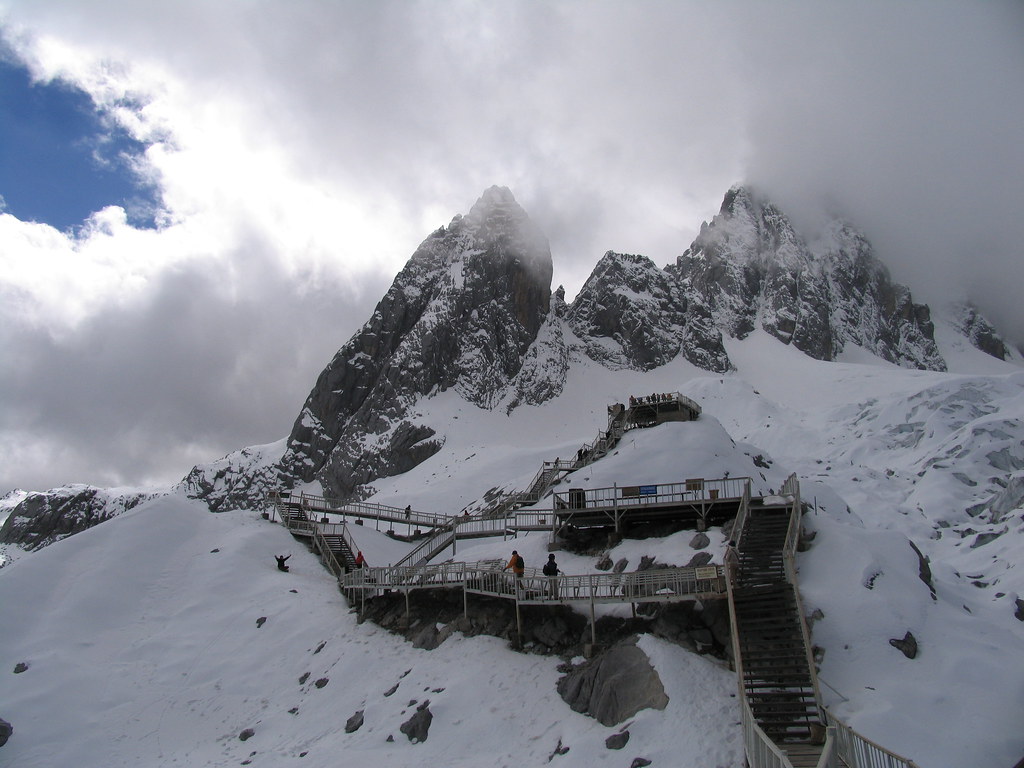
Glacier Park represents the pinnacle of any Jade Dragon Snow Mountain visit. At Glacier Park you could ascend to an elevation of 4,680 m (15,350 ft) — the highest that visitors typically reach. The journey begins with the Glacier Park Cable Car (also called the Big Ropeway), which transports visitors from 3,356 meters to 4,506 meters in just 15 minutes.
From the upper cable car station, a wooden boardwalk leads upward through increasingly thin air to the highest accessible point at 4,680 meters. The views from this elevation are simply breathtaking – on clear days, you can see the entire mountain range stretching endlessly toward Tibet, with the sacred peaks of Meili Snow Mountain visible in the distance.
Pro Tip: The final climb from the cable car station to the summit viewing platform gains 174 meters in elevation. Take frequent breaks and stay hydrated to avoid altitude sickness.
Blue Moon Valley (Lanyue Gu) – A Photographer’s Paradise
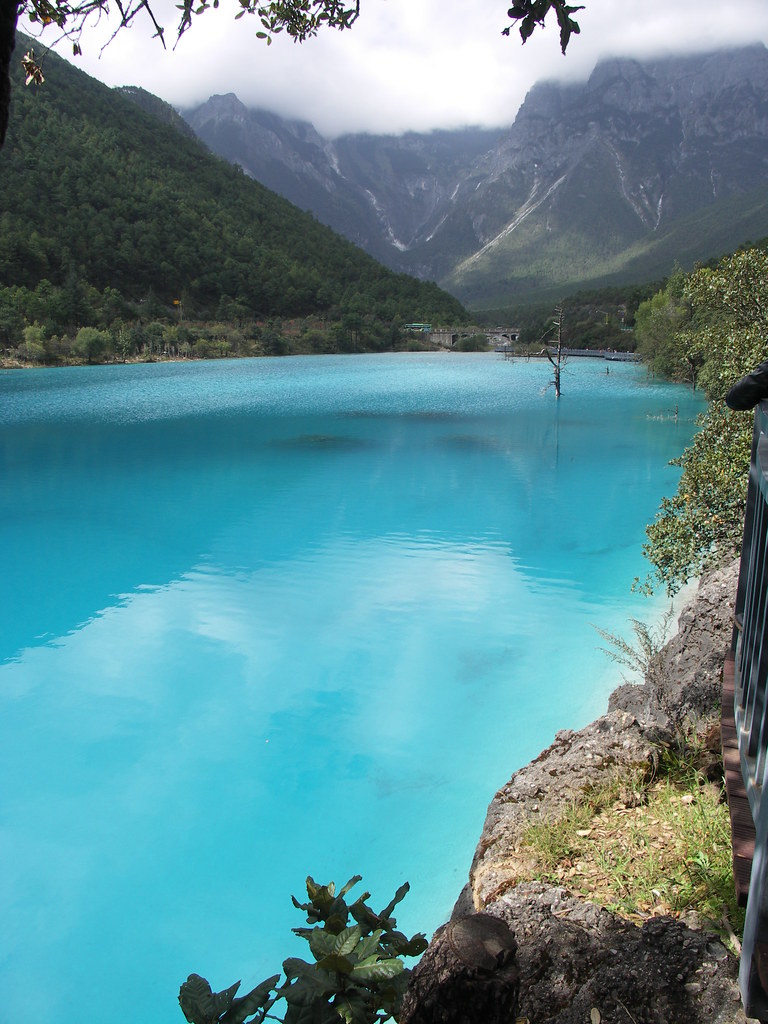
Blue Moon Valley: This crescent-shaped valley offers some of the most stunning alpine scenery in all of China. The valley features four distinct lakes – White Water Lake, Blue Moon Lake, Listening-to-the-Tao Lake, and Mirror Pool Lake – each with its own character and photographic opportunities.
The lakes’ extraordinary blue color comes from dissolved minerals carried by glacial melt, creating an almost supernatural appearance that changes with the light throughout the day. The contrast between the turquoise waters, white limestone terraces, and snow-capped peaks provides endless photographic inspiration.
During my visits, I’ve found that the best light for photography occurs in the late morning (10-11 AM) when the sun fully illuminates the water while maintaining good contrast with the mountain backdrop.
Spruce Meadow (Ganhaizi) – Cultural Immersion
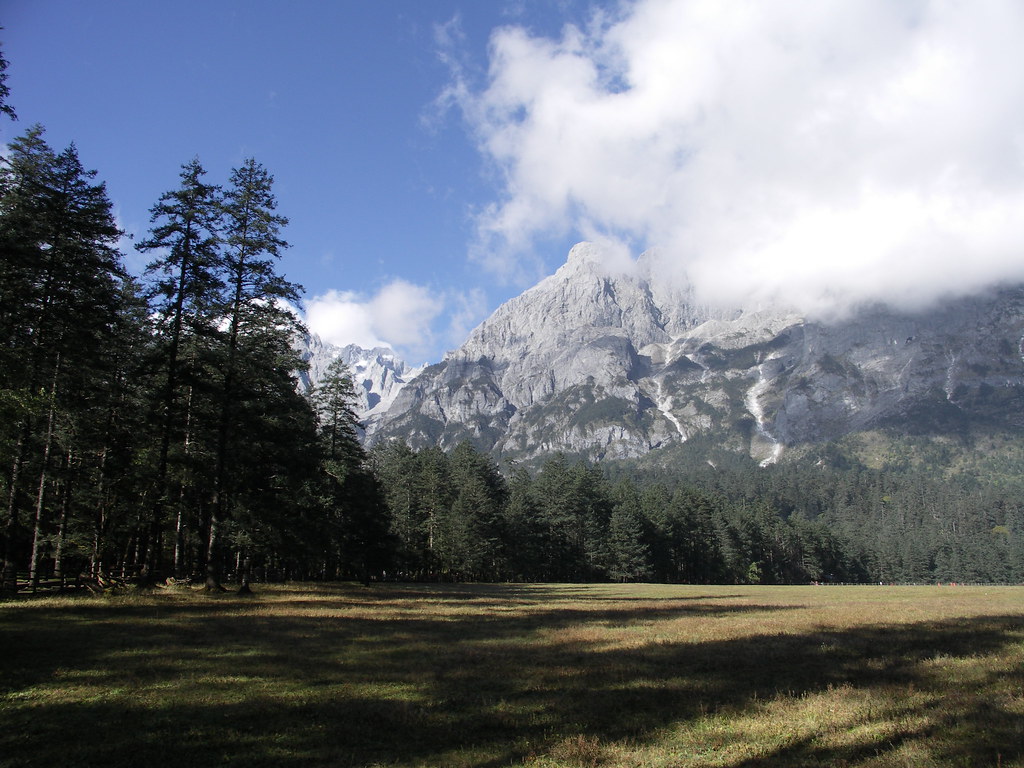
Spruce Meadow is a smaller and more accessible area near Blue Moon Valley. It features dense spruce forests…. This area offers a gentler introduction to the mountain’s ecology while providing rich cultural experiences.
The meadow serves as a gathering place for Naxi cultural performances, including traditional music concerts featuring ancient instruments like the Naxi pipa and hulusi. Along the path are traditional Naxi culture totems and markers, offering insight into the local culture amidst the natural beauty of the park.
Yak Meadow (Maoniuping) – Alpine Adventure

Accessible via the Middle Ropeway, Yak Meadow sits at 3,700 meters elevation and offers a more intimate mountain experience. The expansive alpine meadow provides excellent opportunities for short hikes while enjoying panoramic views of the main peak.
During summer months, the meadow bursts with wildflowers, including several endemic species found only in this region. The area also features traditional yak herding, providing authentic glimpses into highland pastoral life.
DIG DEEPER: Glacier Park vs Yak Meadow vs Spruce Meadow – Which Should You Choose?
Practical Travel Tips for Jade Dragon Snow Mountain
Essential Preparation for High Altitude
Altitude preparation cannot be overstressed when visiting Jade Dragon Snow Mountain. The rapid elevation gain from Lijiang (2,400m) to Glacier Park (4,680m) can trigger altitude sickness in unprepared visitors.
Pre-Visit Preparation:
- Arrive in Lijiang at least one day before attempting the mountain ascent
- Stay well-hydrated and avoid alcohol for 24 hours before your visit
- Consider purchasing oxygen canisters (available at the park entrance for ¥68-98)
- Wear layers as temperatures can vary dramatically between locations
During Your Visit:
- Ascend slowly and take frequent breaks
- Watch for altitude sickness symptoms: headache, nausea, dizziness, fatigue
- Descend immediately if symptoms worsen
- The park medical stations are located at key elevations for emergencies
Transportation and Access Options
From Lijiang:
- Bus Route 101: Direct service from Lijiang Bus Station (¥15, 1 hour)
- Private Tour: Most convenient option including hotel pickup (¥200-400 per person)
- Taxi: Approximately ¥80-120 one way, negotiate return time
- Rental Car: Self-drive option for experienced mountain drivers
Within the Park: The park operates an efficient shuttle bus system connecting major attractions. Typically, there are three common routes for travelers to explore Jade Dragon Snow Mountain: Glacier Park via the Big Ropeway, Yak Meadow via the Middle Ropeway, and Spruce Meadow via the Small Ropeway.
Equipment and Clothing Recommendations
Essential Items:
- Warm jacket (temperatures can drop to -10°C at high elevations)
- Waterproof outer layer for sudden weather changes
- Comfortable hiking boots with good grip
- Sunglasses and sunscreen (UV reflection off snow is intense)
- Camera with extra batteries (cold drains battery life quickly)
Optional but Recommended:
- Hiking poles for the final ascent to Glacier Park summit
- Portable oxygen (available for purchase at park entrance)
- Thermos for hot drinks during breaks
Best Time to Visit Jade Dragon Snow Mountain
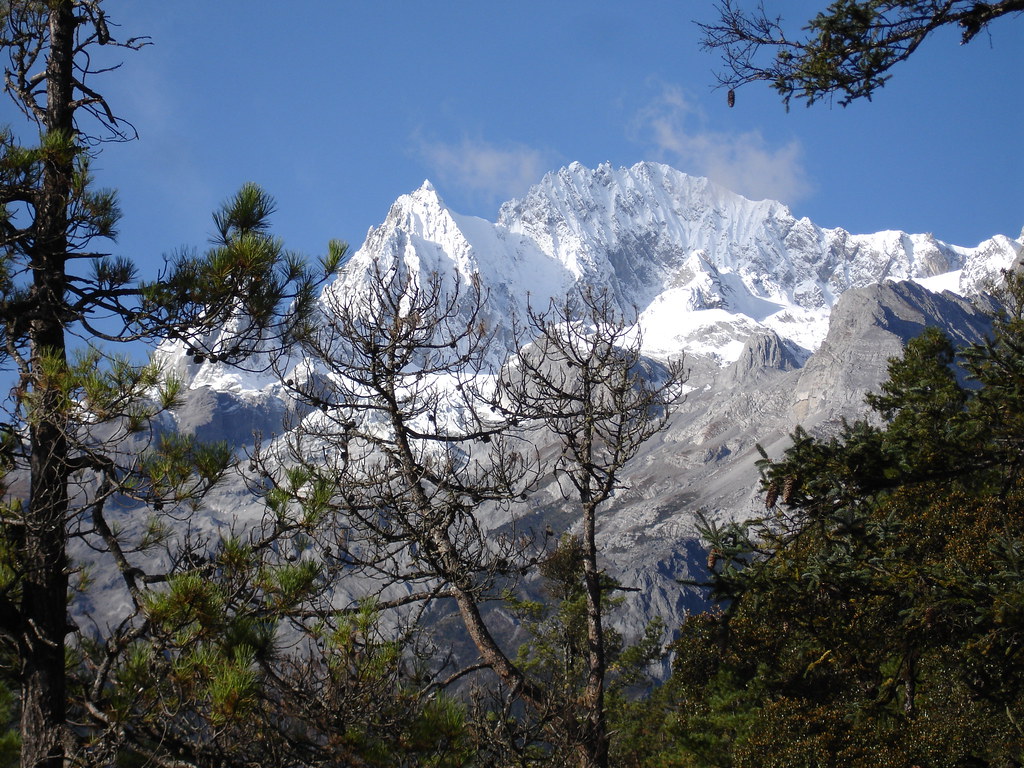
Peak Season: October to April
The optimal visiting window spans from October through April, when clear skies provide unobstructed mountain views and stable weather conditions prevail. During this period, the contrast between the snow-covered peaks and blue skies creates the most dramatic and photogenic conditions.
October to December: Autumn casts a golden glow over Jade Dragon Snow Mountain, with forests turning vibrant shades of orange, red, and yellow. Visitor numbers decrease, offering a more peaceful experience. This period offers the perfect combination of stable weather, fewer crowds, and spectacular fall colors in the lower elevations.
January to March: Winter brings the most snow coverage and clearest atmospheric conditions. Temperatures are cold but manageable with proper clothing. This is the best time for glacier viewing and photography, though weather can change rapidly.
April: Spring emergence begins at lower elevations while maintaining excellent snow coverage on the peaks. Wildflowers start blooming in the valleys, creating beautiful contrast photography opportunities.
Shoulder Season: May and September
May and September offer acceptable visiting conditions with some trade-offs:
- May: Spring weather with occasional rain and cloud cover
- September: Post-monsoon clarity but with higher humidity and some afternoon clouds
Avoid: June to August (Monsoon Season)
The summer monsoon season brings heavy rainfall, persistent cloud cover, and reduced visibility. Mountain views are often completely obscured, making the journey less rewarding. Additionally, the wet conditions create slippery trails and increased rockfall risk.
Special Experiences and Hidden Gems
Sunrise Photography at Glacier Park
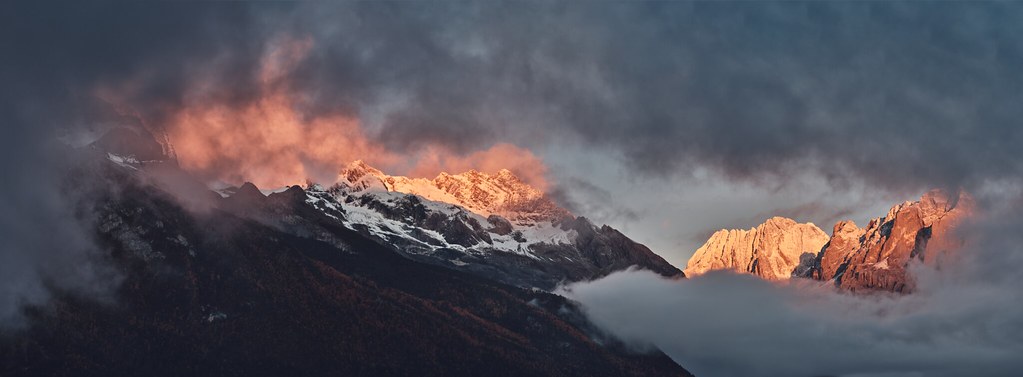
For the ultimate Jade Dragon Snow Mountain experience, consider the early morning photography expedition. The first cable car typically operates at 9:30 AM, but special sunrise tours can sometimes arrange earlier access for serious photographers.
The alpenglow effect on the snow peaks creates an otherworldly pink and orange illumination that lasts only 10-15 minutes but provides unforgettable imagery. The challenge lies in the extremely cold pre-dawn temperatures at elevation, often dropping below -15°C.
Traditional Naxi Music Performances

Several locations within the scenic area host authentic Naxi cultural performances. The most acclaimed is the “Impression Lijiang” show, an outdoor performance set against the mountain backdrop that combines traditional music, dance, and storytelling.
These performances provide crucial cultural context for understanding the mountain’s spiritual significance to local communities. The music often incorporates natural sounds from the mountain environment, creating an immersive cultural experience.
Read also: Must-See 3 Impression Shows by Zhang Yimou: Experience China’s Most Breathtaking Cultural Performances
Botanical Photography Opportunities

For nature photography enthusiasts, the mountain offers extraordinary opportunities to document endemic plant species. The rhododendron forests (blooming April-May) create tunnels of vibrant colors, while the alpine meadows host unique high-altitude wildflowers found nowhere else in the world.
Endemic Species to Look For:
- Jade Dragon Snow Mountain rhododendron (Rhododendron principis)
- Yunnan blue poppy (Meconopsis betonicifolia)
- Various endemic primula species
- High-altitude gentians
Winter Sports and Activities
The ski resort in Jade Dragon Snow Mountain Scenic Area is located in eastern part of the place, with an altitude of 4500-4700 meters. It is covered with snow in all year around. This makes it one of the few year-round skiing destinations in China, though the short run length (1000 meters) makes it more of a novelty experience than a serious skiing destination.
Frequently Asked Questions
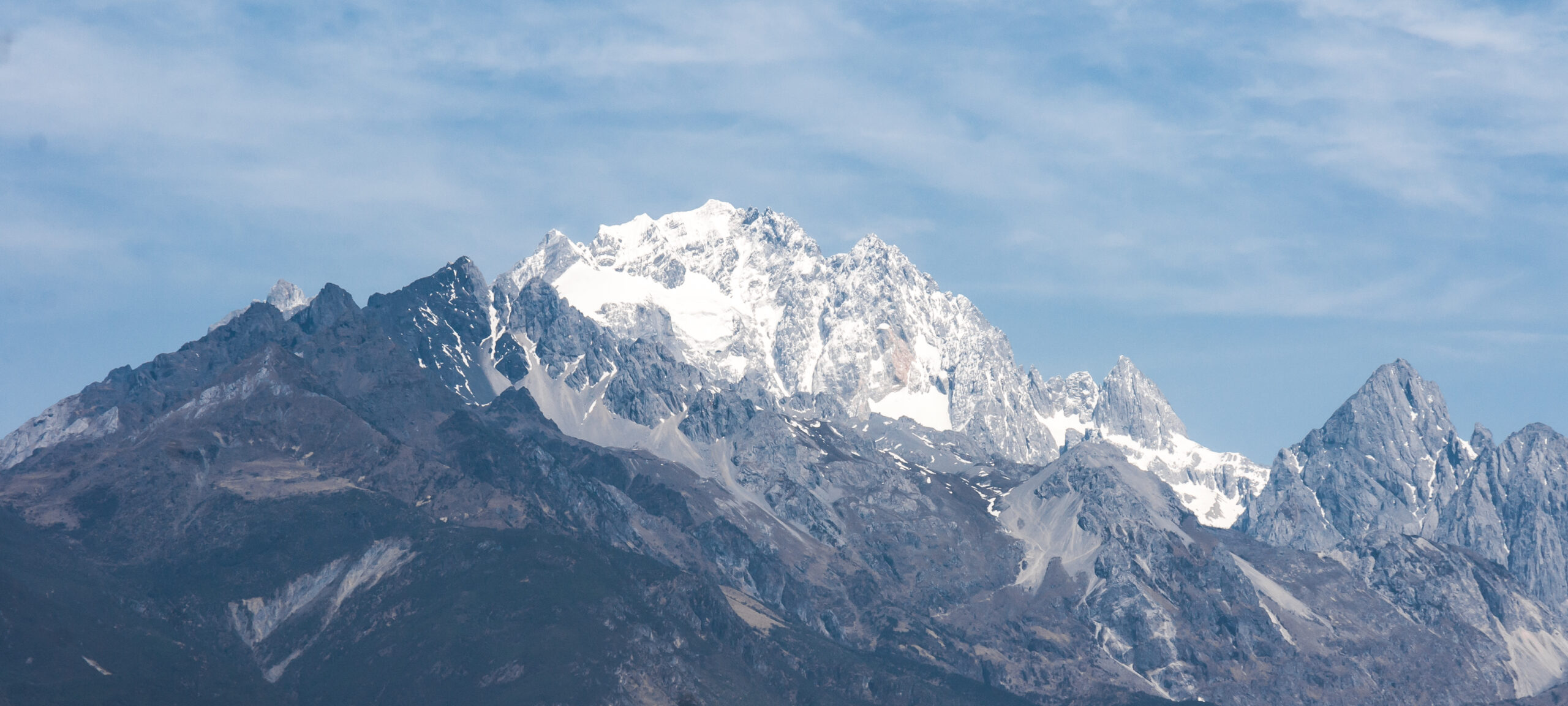
Is Jade Dragon Snow Mountain suitable for beginners?
Yes, the mountain offers experiences for all fitness levels. The cable car systems eliminate the need for technical mountaineering skills, and the wooden boardwalks at Glacier Park are accessible to most visitors. However, the high altitude requires basic fitness and altitude awareness.
How long should I allocate for a visit?
A comprehensive visit typically requires 6-8 hours, including transportation from Lijiang. Plan for 2-3 hours at Glacier Park, 1-2 hours at Blue Moon Valley, and additional time for other attractions based on your interests.
Can I visit independently or do I need a tour?
Independent visits are entirely possible and often more rewarding. The park’s shuttle bus system and clear signage make navigation straightforward. However, tours can provide valuable cultural context and handle logistics efficiently.
What happens if weather conditions deteriorate?
The park may close cable car operations during high winds or severe weather. Weather changes rapidly at altitude, so morning visits generally offer the best conditions. Check weather forecasts and have flexible plans.
Are there accommodation options within the park?
No overnight accommodation exists within the scenic area itself. All visitors must return to Lijiang or nearby towns for lodging. This policy helps preserve the mountain’s natural environment.
How crowded does the mountain get?
Peak crowding occurs during Chinese holidays (Golden Week in October, Spring Festival) and summer weekends. Weekday visits, especially Tuesday through Thursday, offer the most peaceful experience with shorter cable car queues.
Planning Your Visit: Getting There, Tickets, and Logistics

Entrance Fees and Ticketing
Complete Pricing Guide (2026)
Base Entry Fee All visitors must purchase the mountain entry ticket before accessing any cable car services.
Item | Price (RMB) |
|---|---|
Jade Dragon Snow Mountain Entry Ticket | 100 |
Cable Car Package Options
Package Type | Glacier Park | Yak Meadow | Spruce Meadow |
|---|---|---|---|
Cable Car + Shuttle Bus | 140 | 65 | 60 |
Cable Car + Shuttle Bus + Specialty Buffet | 178 | 103 | 98 |
Cable Car + Shuttle Bus + Impression Lijiang Show | 300 | 225 | 220 |
Additional Entertainment Options
Show Type | Price (RMB) |
|---|---|
Impression Lijiang Show (Regular Ticket) | 280 |
Impression Lijiang Show (VIP Ticket) | 346 |
Budget Planning Examples
- For Glacier Park experience: Base entry (100) + Cable car package (140) = 240 RMB minimum
- For Yak Meadow experience: Base entry (100) + Cable car package (65) = 165 RMB minimum
For Spruce Meadow experience: Base entry (100) + Cable car package (60) = 160 RMB minimum
The specialty buffet adds 38 RMB to basic packages, while the Impression Lijiang show adds 160 RMB to cable car packages. VIP show tickets cost 66 RMB more than regular show tickets.
Money-Saving Tip: Purchase combo tickets that include admission and cable car access for slight discounts. Tickets can be bought online through official platforms or at the park entrance.

NOTE: During peak travel seasons, cable car tickets—especially for the Glacier Park Cableway—are extremely hard to get. Please note that starting from January 21, 2025, tickets for the Jade Dragon Snow Mountain cableways will be available for pre-sale 7 days in advance. If you plan to book them yourself, be sure to watch for this booking window.
Operating Hours and Seasonal Variations
Peak Season (November-April):
- Park opens: 8:30 AM
- Last cable car up: 4:00 PM
- Park closes: 5:30 PM
Off-Season (May-October):
- Park opens: 8:00 AM
- Last cable car up: 4:30 PM
- Park closes: 6:00 PM
Cable car operations may cease temporarily due to high winds or other weather conditions. Morning arrivals provide the best chance of optimal conditions.
Getting to Jade Dragon Snow Mountain
From Lijiang Airport: Distance: 45 kilometers (approximately 1 hour)
- Taxi: ¥120-150 direct to mountain entrance
- Airport shuttle to city center, then Bus 101 to mountain
From Lijiang Ancient Town: Distance: 25 kilometers (approximately 40 minutes)
- There was a bus straight from the city at 7am which we hopped on and the closer we got the busier it became.
- Bus 101: Most economical option (¥15)
- Private car: ¥80-120 for round trip
- Tour van: Included in most organized tours
From Dali: Distance: 180 kilometers (approximately 3 hours)
- High-speed train to Lijiang, then local transportation to mountain
- Direct tour buses available during peak season
Recommended Itinerary for Different Visit Lengths
Half-Day Visit (4-5 hours):
- Focus on Glacier Park via Big Ropeway
- Quick stop at Blue Moon Valley
- Best for travelers with limited time
Full-Day Visit (7-8 hours):
- Morning: Glacier Park ascent and exploration
- Afternoon: Blue Moon Valley and Spruce Meadow
- Optional: Yak Meadow if time permits
Two-Day Experience:
- Day 1: Comprehensive mountain exploration
- Day 2: Cultural immersion in Lijiang with mountain views
- Allows for weather contingency and relaxed pace
Conclusion: Embracing the Magic of Jade Dragon Snow Mountain

Jade Dragon Snow Mountain represents far more than a typical tourist destination – it embodies the intersection of natural wonder, cultural heritage, and spiritual significance that defines the best of China’s protected landscapes. The mountain’s ability to transport visitors through multiple climate zones and ecosystems within a single day creates an almost mystical journey that few other destinations can match.
The experience of standing at 4,680 meters, surrounded by pristine glacial formations while breathing the thin mountain air, provides perspective that extends far beyond the physical realm. It connects modern travelers to the same sense of awe and reverence that has inspired the Naxi people for over a millennium.
For those seeking authentic natural beauty combined with rich cultural experiences, Jade Dragon Snow Mountain delivers on every level. The careful balance between accessibility and preservation means that visitors can experience this remarkable landscape while knowing that future generations will enjoy the same untouched beauty.
Whether you’re drawn by the challenge of high-altitude exploration, the allure of endemic wildlife photography, or the desire to understand ancient spiritual traditions, Jade Dragon Snow Mountain provides a transformative experience that resonates long after departure. The mountain teaches patience, respect for natural forces, and appreciation for the delicate relationships between human culture and pristine wilderness.
Read also: Top 10 Mountains in China: Majestic Peaks You Must Explore
A Personal Note from Our Team
After years of guiding travelers through China’s most spectacular destinations, we can confidently say that Jade Dragon Snow Mountain holds a special place among the country’s natural treasures. The mountain has taught us that the most meaningful travel experiences occur when we approach destinations with respect, preparation, and openness to learning.
Every visit to the mountain reveals new details and perspectives. The interplay of light and shadow across the glacial faces changes throughout the day, creating unique moments that cannot be replicated or predicted. This dynamic quality keeps drawing me back, and I’ve found that even experienced mountain travelers discover something unexpected with each ascent.
The mountain’s cultural significance adds depth that transforms a scenic visit into a cultural immersion. Understanding the Naxi people’s spiritual connection to these peaks enriches every moment spent in their shadow. It reminds us that truly exceptional destinations touch both the spirit and the senses.
As you plan your journey to Jade Dragon Snow Mountain, remember that the mountain rewards those who come prepared but remain flexible. Weather, altitude, and natural rhythms all play roles in shaping your experience. Embrace these variables as part of the adventure, and you’ll discover why this sacred peak continues to inspire travelers from around the world.
The team at Travel China With Me has witnessed countless visitors experience their first glimpse of the mountain’s snow-covered peaks emerging from morning clouds. That moment of recognition – when travelers realize they’re witnessing something truly extraordinary – never loses its impact. We look forward to helping you create your own unforgettable memories on this remarkable mountain.
Safe travels, and may your journey to Jade Dragon Snow Mountain exceed all expectations.


